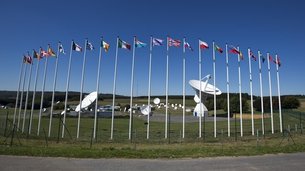EDRS-A, Europe’s SpaceDataHighway pioneer, has been in orbit for a month and its testing is going well. The Redu team in Belgium are now pushing it ever-closer to full service by laying the groundwork for it to be ready for its first laser links to the Copernicus Sentinels.
The European Data Relay System’s EDRS-A node was launched on 29 January as a hosted payload aboard Eutelsat’s Eutelsat-9B satellite. As the establishing stone of the SpaceDataHighway network, it is extremely important that the payload is in good health.
Testing began two weeks after the Eutelsat satellite was launched and while it was still travelling towards its final position at 9°E, over Europe.
The tests are being performed by a pan-European web of ground and control centres managed by the various partners with Redu Space Services of Belgium playing a key role.
RSS are carrying out most of the EDRS-A payload tests from ESA’s Redu Centre in Belgium in coordination with the DLR German Space Operations Center (GSOC) in Oberpfaffenhofen, Germany, and Eutelsat’s Satellite Control Centre in Rambouillet, France. Airbus Defence and Space hold the overall responsibility as the EDRS partnership prime.
EDRS-A has two antennas. One large and fixed in place, for beaming data down to Europe via Ka-band radio frequencies, and one small and mobile, which will be used for locking on to low-orbit vehicles such as the International Space Station.
ESA’s EDRS-A Procurement Manager Khalil Kably notes: “Launches put a lot of stress on intricate, sophisticated technology like that of EDRS. The equipment must endure a very violent environment – both in vibrations and acoustically. The Redu Centre has been making sure the payload’s power is as expected and antennas are still in good health after the trial.”
They’ve done so by comparing the strength of EDRS-A’s down- and uplink beams with the performance of the payload when it was still on the ground. The Redu team have also mapped the antennas’ coverage by comparing it to predicted models.
Formally recognised in 2014 as ‘critical infrastructure’ by ESA and Belgium, the ESA Redu centre has been in charge of monitoring the first steps of some of ESA’s most important projects.
Every satellite of the European Commission’s flagship navigation programme Galileo has been tested at Redu after launch. The Centre also controls all three of ESA’s flying Proba satellites, and over the years has been involved with all European satellite operators in one way or another.
ESA Director of Telecommunications Magali Vassiere said: “Redu has a great deal of in-orbit testing heritage, which is why it was chosen as the EDRS Backup Mission Operation Centre. Redu is building expertise and securing a promising role as Europe’s hub for ground segment activities.”
Redu has been following the progress of EDRS-A using its new Ka-band antenna – one of more than 30 that have been built over the past decade to develop the site as a world-class operations centre.



















